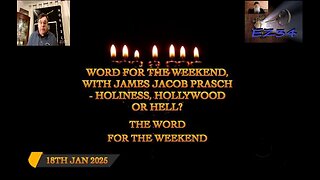Premium Only Content

The Eastern Gate - Jacob Prasch
The low down....
The Old City of Jerusalem is surrounded by a wall containing eight major gates. Moving counter-clockwise from the northern-most gate are Herod’s Gate, the Damascus Gate, the New Gate, Jaffa Gate, Zion Gate, the Dung Gate, the Eastern Gate, and the Lions’ Gate. The Eastern Gate, facing the Mount of Olives across the Kidron Valley, is unique in that it is completely sealed shut. Some commentators see the Eastern Gate’s obstruction as a fulfillment of biblical prophecy.
The Eastern Gate of Jerusalem is also called the Golden Gate or the Beautiful Gate (Acts 3:2). In Hebrew, it is Sha'ar Harahamim, the “Gate of Mercy.” It is currently the oldest gate in the Old City, having been constructed in the 6th or 7th century AD. Also, it is the gate that gives the most direct access to the temple mount—if a person could pass through the arches of the Eastern Gate, he would be very close to where the Jewish temple used to stand. When Jesus entered Jerusalem from the Mount of Olives in Matthew 21, He used a gate in the same location as the current Eastern or Golden Gate.
The Eastern Gate was sealed shut in AD 1540–41 by order of Suleiman the Magnificent, a sultan of the Ottoman Empire. It’s believed that the reason for the closing of the Eastern Gate was to prevent the Jewish Messiah from gaining entrance to Jerusalem. Jewish tradition states that the Messiah will pass through the Eastern Gate when He comes to rule. The Muslim Suleiman was attempting to thwart the Messiah’s plans with sixteen feet of cement. The Eastern Gate has remained sealed for nearly the past 500 years.
It’s the sealing of Jerusalem’s Eastern Gate that has caused many students of prophecy to sit up and take notice. The book of Ezekiel contains several references to a gate that faces east. In Ezekiel 10:18–19, the prophet sees the glory of the Lord leave the temple through “the entrance of the east gate of the Lord’s house”; the glory then moves east of the city to the Mount of Olives (Ezekiel 11:23). Later, Ezekiel sees the glory of the Lord return to the temple via “the gate facing east” (Ezekiel 43:1–5).
Then, in Ezekiel 44:1–2, the gate being closed: “The man brought me back to the outer gate of the sanctuary, the one facing east, and it was shut. The Lord said to me, ‘This gate is to remain shut. It must not be opened; no one may enter through it. It is to remain shut because the Lord, the God of Israel, has entered through it.’” Finally, in Ezekiel 46:12 we read that there is one person, a “prince,” who may enter via the eastern gate: “When the prince provides a freewill offering to the LORD . . . the gate facing east is to be opened for him. . . . Then he shall go out, and after he has gone out, the gate will be shut.”
Some interpret these passages in Ezekiel as references to the Lord Jesus Christ. The glory of the Lord coming into the temple is seen as the triumphal entry (Ezekiel 43:2; Matthew 21:1–11). The command to permanently shut the gate because the Lord has entered it (Ezekiel 44:2) is seen as a prediction of the walling-up of the Eastern Gate by the Muslims in AD 1540. And, finally, the “prince” to whom the gate will be opened (Ezekiel 46:12) is seen as Christ Himself at the second coming—the Prince of Peace will return to the Mount of Olives (Zechariah 14:4) and enter Jerusalem by way of the re-opened Eastern Gate.
This interpretation is popular and leads to much dramatic speculation about how and when the Eastern Gate will be unsealed. However, there are some textual problems with that interpretation.
First, there is a difficulty in connecting Ezekiel’s “gate facing east” with the Eastern Gate of the Old City of Jerusalem. Ezekiel specifically says the gate he saw is “the outer gate of the sanctuary” (Ezekiel 44:1); that is, it’s a gate of the temple court, not a gate of the city.
Second, the Eastern Gate of Jerusalem is not the same one that Jesus rode through in His triumphal entry. The modern Eastern Gate was not constructed until centuries after the time of Christ. The original gate that Nehemiah built (and possibly dating to the time of Solomon) is underground, below the current gate, as documented by archaeologist James Fleming in 1969. It was through the lower gate (now underground) that Jesus would have entered Jerusalem in AD 30.
Third, the temple that Ezekiel sees in chapters 40–47 is not the same temple that Jesus was in, and the Jerusalem he describes is quite different from the Old City of Jerusalem that we know of today. The millennial temple (the third temple) measured in Ezekiel is significantly larger than the first two temples, and the Jerusalem of the millennium will have twelve gates, not eight (Ezekiel 48:30–35).
Finally, and most importantly, the “prince” in Ezekiel 46 is not the Messiah. Rather, he is the overseer of Jerusalem during the millennial kingdom. He is not Jesus, but he serves under Jesus’ authority. We know that this prince is not the Lord because he must make a sin offering for himself as well as the people: “On that day the prince is to provide a bull as a sin offering for himself and for all the people of the land” (Ezekiel 45:22). Whoever the prince is, he is a man with a sin nature that must be atoned for.
In summary, the “gate facing east” that Ezekiel describes is different from the Eastern Gate visible today in the old wall of Jerusalem. The current (sealed) gate did not exist at the time of Christ, so the Lord never entered it. The location of the earlier Eastern Gate (the one Jesus entered) is below present-day ground level, and it does not agree with the detailed description of the future temple complex as given in Ezekiel 40–42.
We surmise, then, that the eastern gate of Ezekiel 44 will be part of the future millennial temple complex. It is yet to be built.
How then do we interpret the coming and going of God’s glory and the closing of the eastern gate in Ezekiel’s prophecy? Like this: the prophet sees the glory of the Lord departing from the temple in chapter 10 because of the gross wickedness of the people—this is the first temple, destroyed by the Babylonians in 586 BC. Later, in chapter 43, Ezekiel sees the glory return to the temple—this is the new, enlarged temple of the millennial kingdom. In chapter 44, Ezekiel is told that the eastern temple gate “is to remain shut because the Lord, the God of Israel, has entered through it” (verse 2). In other words, in the millennium the glory of the Lord will not depart from the temple. The avenue of the prior exit (to the east) is blocked, symbolizing the permanent presence of the Lord among His people. The eastern gate will only be opened on the Sabbath and the New Moon to allow for the priestly duties of the prince (Ezekiel 46:1–2).
-
 58:09
58:09
Singing Springs Ministries~Bringing Solid Food!
2 months agoWord-for-the-Weekend--Holiness-Hollywood-or-Hell
499 -
 LIVE
LIVE
Major League Fishing
5 days agoLIVE! - MLF Bass Pro Tour: REDCREST - Day 4
19,627 watching -
 17:50
17:50
Talk Nerdy Sports - The Ultimate Sports Betting Podcast
6 hours ago4/6/25: 🔥15-1 March Madness Run 🧠🔥 | MLB, NBA & PrizePicks Picks to Cook Your Bookie
49.4K6 -
 31:07
31:07
Real Coffee With Scott Adams
8 hours agoEpisode 2801 CWSA 04/06/25
65.3K44 -
 LIVE
LIVE
GrimmHollywood
6 hours ago🔴LIVE • GRIMM HOLLYWOOD • CLASSIC HALO • WITH THE ROCKSTARS of RUMBLE •
255 watching -
 LIVE
LIVE
MissesMaam
7 hours agoCan we survive the Oregon Trail ? 💚✨
248 watching -
 12:19
12:19
Mrgunsngear
1 day ago $7.71 earnedHUXWRX RAD 9 Suppressor Review
63K25 -
 LIVE
LIVE
JdaDelete
8 hours ago $0.09 earnedThe Legend of Zelda: Oracle of Seasons | Part 2
77 watching -
 LIVE
LIVE
LumpyPotatoX2
4 hours agoSub-Sunday with Casual Verdansk - #RumbleGaming
149 watching -
 23:50
23:50
marcushouse
19 hours ago $6.31 earnedStarship Is About to Do Something It’s Never Done Before - A Huge First!
62.1K20